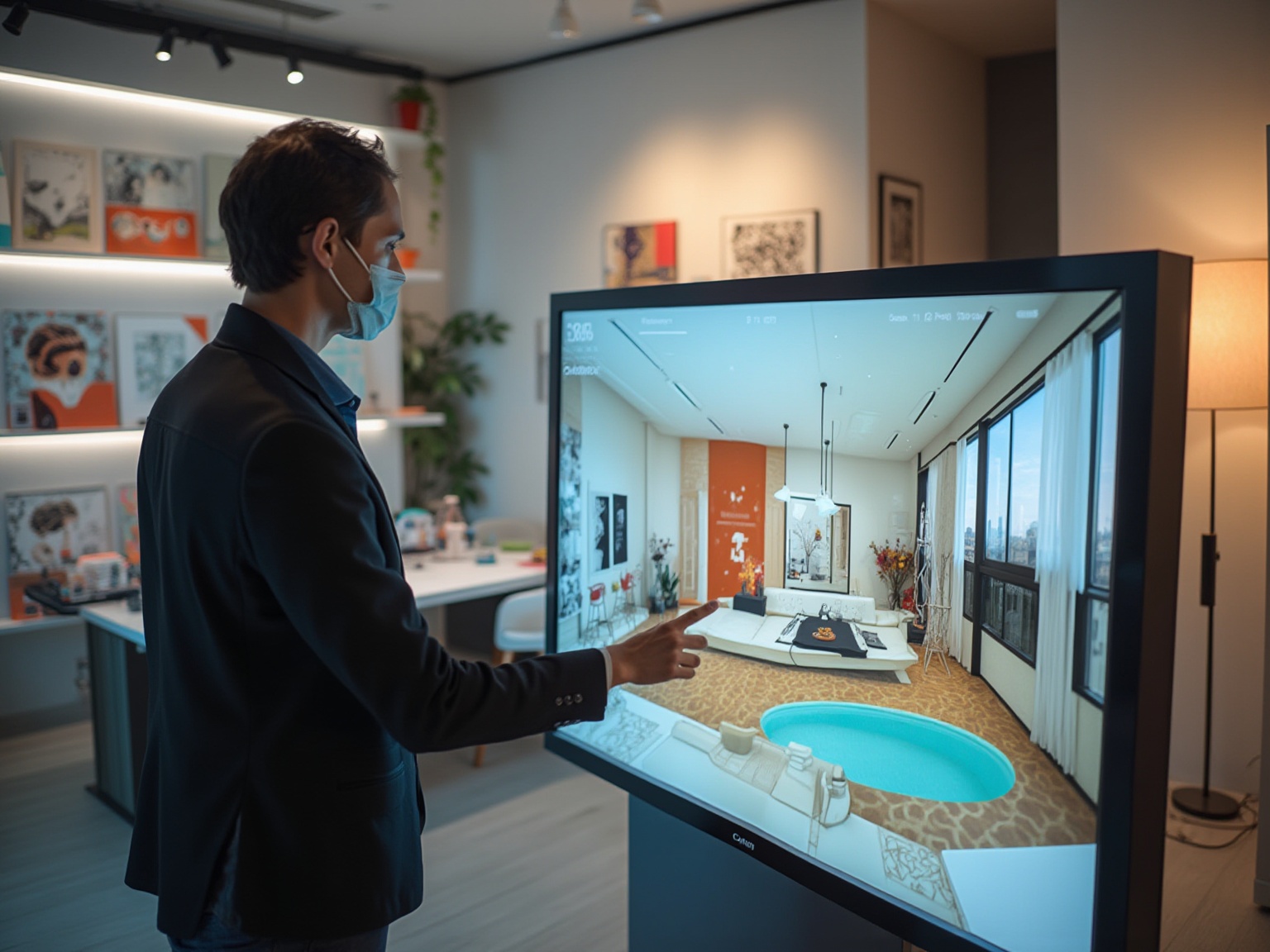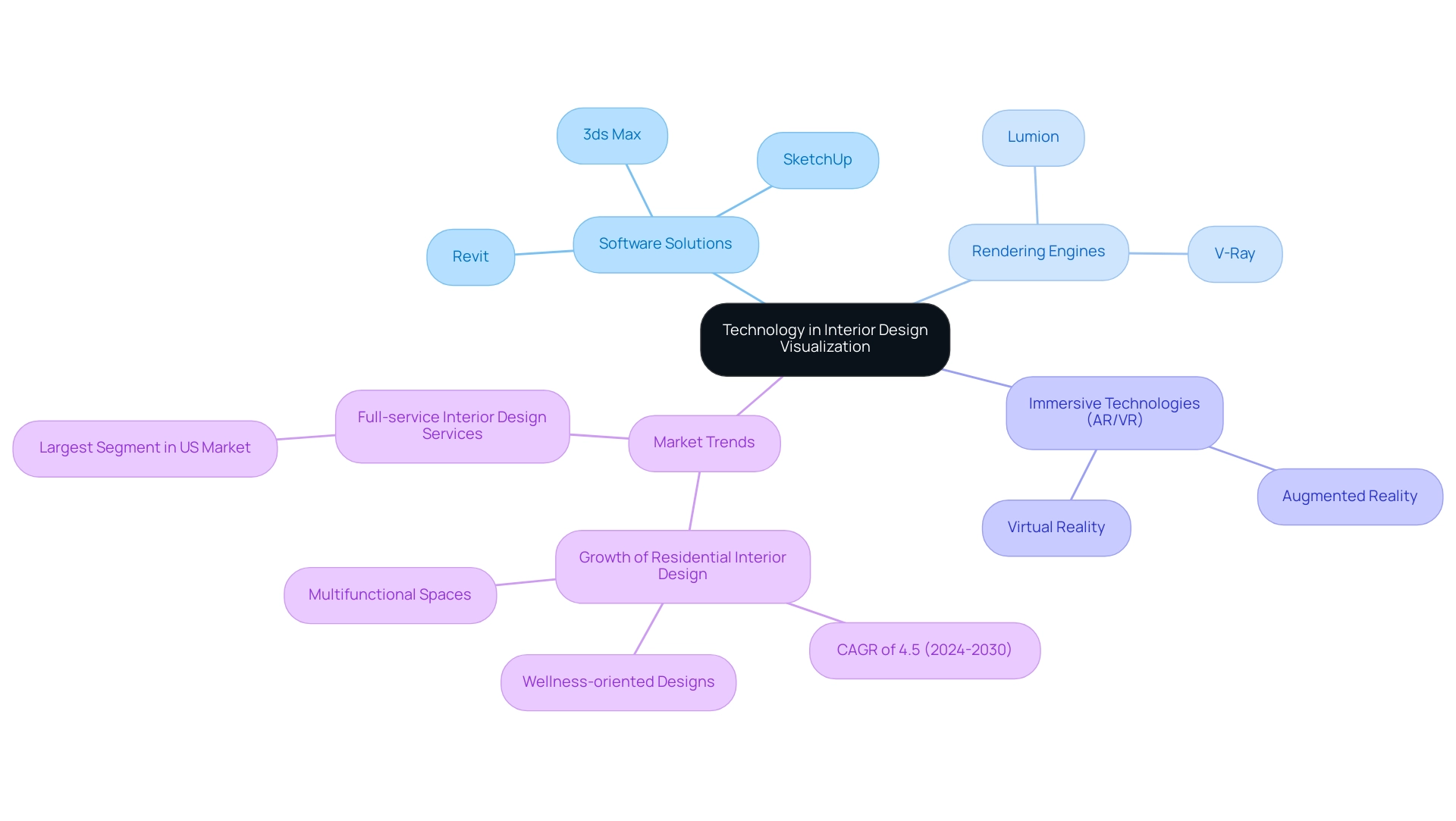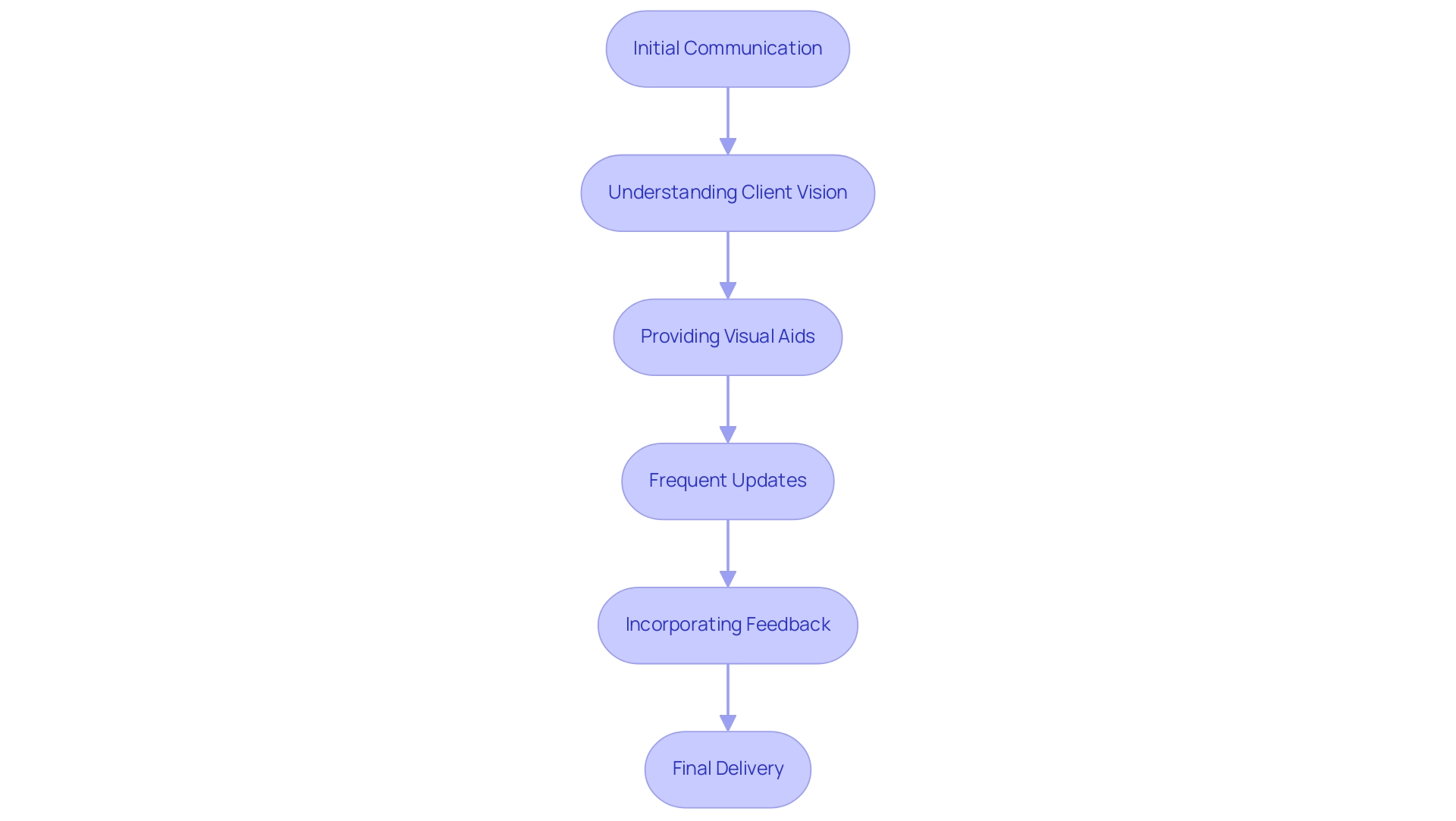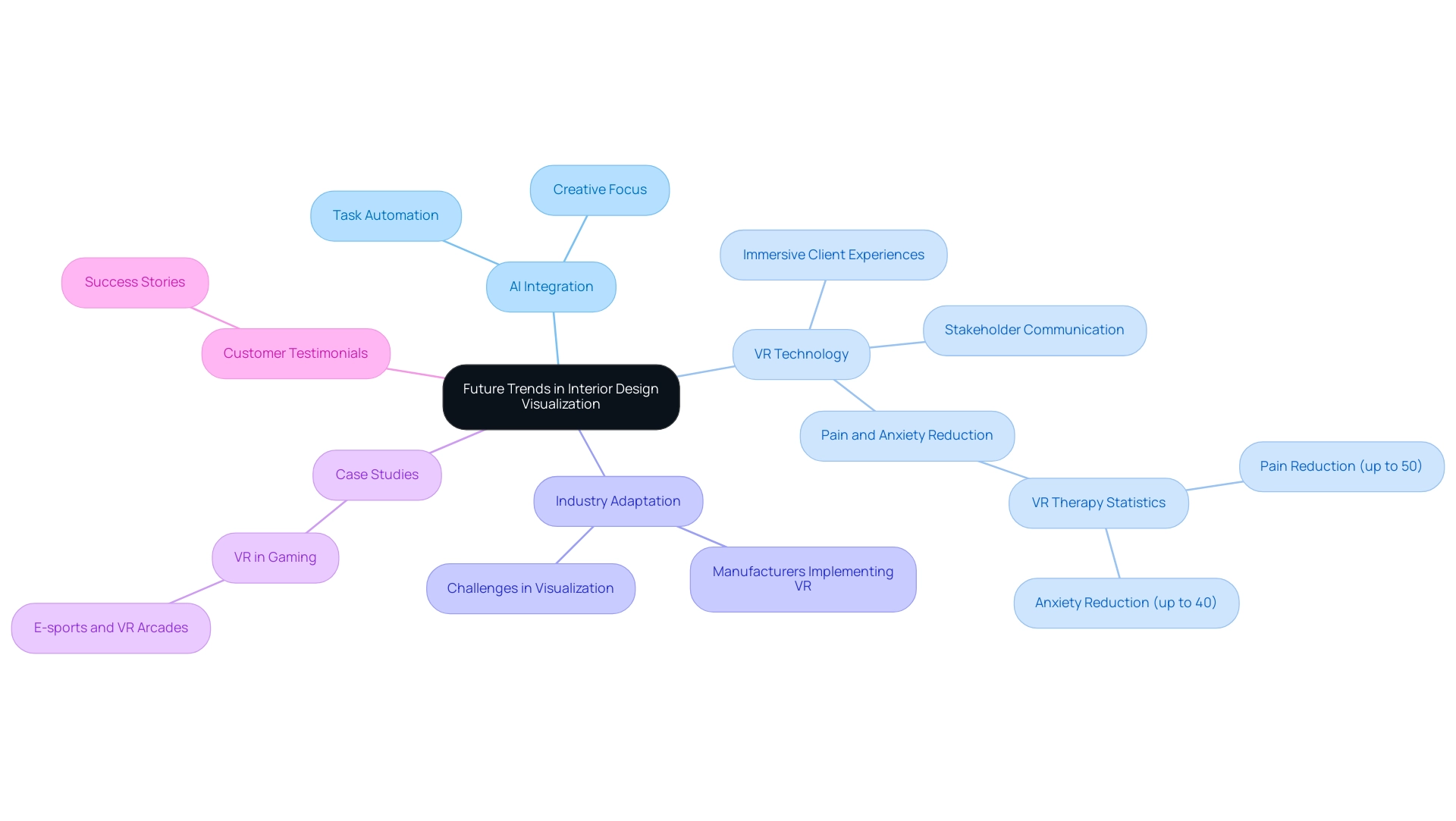Overview
The challenges in interior design visualization for modern homes primarily include the gap between designers’ visions and clients’ expectations, along with technical difficulties in achieving realistic renderings. The article emphasizes that effective communication and the integration of advanced technologies like AI and VR are essential for bridging this gap, enhancing client understanding, and improving overall project outcomes.
Introduction
The realm of interior design visualization is at a pivotal juncture, characterized by both significant challenges and transformative opportunities. As designers strive to align their creative visions with client expectations, the gap between abstract concepts and tangible outcomes often proves daunting. This article delves into the complexities of effective design communication, highlighting the role of advanced technologies such as AI and VR in bridging these divides.
By examining case studies and industry trends, it becomes evident that the integration of sophisticated rendering techniques and immersive experiences not only enhances client understanding but also drives project success. As the industry evolves, understanding these dynamics will be essential for designers aiming to navigate the intricate balance of creativity and technical limitations in their visualization endeavors.
Key Challenges in Interior Design Visualization
The challenges in interior design visualization for modern homes encompass significant obstacles that can hinder the effective representation of design concepts. A primary concern is the persistent challenges in interior design visualization for modern homes, particularly the discrepancy between a designer’s vision and the client’s expectations. Clients frequently find it challenging to grasp abstract ideas, which highlights the challenges in interior design visualization for modern homes, resulting in misalignments in outcomes.
This gap can be bridged through a robust collaborative planning process, as demonstrated by our work with J. Scott Smith Visual Designs, where detailed interior illustrations played a crucial role in showcasing both functionality and aesthetics. During our initial discussions, we shared sample images from previous projects, which facilitated a clearer understanding of the customer’s vision and expectations. Such depictions not only elucidate the designer’s intentions but also improve customer satisfaction and marketing effectiveness.
They offer a concrete reference for contractors, removing design misinterpretations and guaranteeing that what customers envision is effectively conveyed.
Furthermore, the significant technical difficulties encountered are part of the challenges in interior design visualization for modern homes when trying to achieve realistic lighting and materials within images. For instance, our team at J. Scott Smith Visual Designs faced difficulties in accurately depicting the open and innovative kitchen space that the customer desired. This necessitated a comprehensive understanding of rendering methods and software functionalities to ensure the final product met the high standards of the customer.
Recent statistics reveal that over 30% of larger firms are now integrating AI into their workflows, yet smaller firms, particularly those with five employees or fewer, lag significantly at just 8%. This gap underscores the necessity for advanced tools to enhance visualization accuracy and facilitate communication, particularly when addressing the challenges in interior design visualization for modern homes, especially in light of time constraints and budget limitations. As emphasized by ThinkLab, the heightened dependence on digital platforms for communication between creators and customers reflects a rising trend towards incorporating innovative solutions in creative processes.
Moreover, the advent of AI-driven virtual consulting platforms in interior decor has changed the landscape, allowing immersive consultations that meet customer expectations more efficiently. These innovations transcend traditional geographic limitations, facilitating a more dynamic interaction between customers and designers. However, the industry must also navigate challenges related to continuous professional development and ethical considerations, ensuring authenticity and trust remain at the forefront of client-designer relationships.
Ultimately, the use of 3D visualizations not only enhances client understanding but also leads to cost savings in development through early issue resolution and adjustments, thereby improving overall outcomes.
The Role of Technology in Enhancing Visualization Techniques
The integration of cutting-edge technology is pivotal in overcoming the challenges in Interior design visualization for modern homes, especially as the global home decor market is forecasted to reach $161.68 billion by 2029. Advanced software solutions, like 3ds Max, SketchUp, and Revit, help address the challenges in Interior design visualization for modern homes by enabling creators to produce high-fidelity 3D models that accurately reflect their visions while allowing for customized concept visualizations based on specific project requirements. The incorporation of sophisticated rendering engines like V-Ray and Lumion further enhances this capability, addressing the challenges in Interior design visualization for modern homes by allowing for the simulation of realistic lighting and material properties essential for effective visual communication.
Furthermore, the advent of augmented reality (AR) and virtual reality (VR) is revolutionizing the creative landscape and tackling the challenges in Interior design visualization for modern homes by enabling clients to engage with virtual environments that offer a comprehensive understanding of intent. These immersive technologies not only enhance the quality of visualizations but also help overcome the challenges in Interior design visualization for modern homes by facilitating a more efficient and collaborative creation process, improving contractor communication and eliminating misunderstandings. Significantly, the level of detail in architectural renderings plays a crucial role in overcoming the challenges in Interior design visualization for modern homes, as it allows homeowners and businesses to visualize the nuances of their concepts, from material textures to spatial relationships.
As residential interior styling is projected to grow at a CAGR of 4.5% from 2024 to 2030, driven by trends towards wellness-oriented and multifunctional spaces, the challenges in Interior design visualization for modern homes will undoubtedly shape the future of interior aesthetics. Moreover, with comprehensive interior creation services being the largest segment in the US market, overcoming the challenges in Interior design visualization for modern homes by utilizing advanced technology is crucial for satisfying the requirements of contemporary customers and improving service offerings, ultimately aligning with their lifestyles and emotional needs.
Enhancing Communication Between Designers and Clients
Effective communication between designers and customers is crucial for addressing the challenges in Interior design visualization for modern homes. Designers must convey their ideas in a manner that is both clear and comprehensible, enabling customers to grasp complex concepts. Visual aids like sketches, mood boards, and initial illustrations serve as effective tools in this context, significantly improving comprehension and enabling constructive feedback.
Our collaborative rendering process at J. Scott Smith Visual Designs begins with initial communication, where we engage with individuals to understand their vision and project goals. Our virtual assistant is available to answer basic questions 24/7, ensuring that customers receive timely support. Frequent updates and check-ins during the design process foster a collaborative environment, enabling timely adjustments based on customer insights.
Notably, effective communication can address the challenges in Interior design visualization for modern homes, ensuring that the final visualizations align closely with client expectations. Once the images meet your specifications, we refine the visuals in the final delivery stage to ensure a polished, professional look. This approach not only emphasizes the importance of detail levels in 3D visuals but also highlights the essential role of high-quality graphical outputs in project development and decision-making.
Furthermore, we accommodate client-requested revisions during the rendering process, ensuring that their feedback is incorporated into the final product. With 31% of internal communication conducted via email and 26% through online chat tools, it becomes evident that the mode of communication significantly impacts the design process. Additionally, portal usage at 24% with an effectiveness of 83% underscores the potential for improved communication strategies.
As noted by Čulo and Skendrovic (2010), the complexity of communication increases with the number of stakeholders, which can lead to distortions in the message conveyed. Thus, prioritizing clear communication and utilizing effective visual aids is paramount in fostering accountability and enhancing overall results. This is further illustrated by the case study titled ‘Boosting Productivity Across Departments with Digital Signage Communication,’ which demonstrates how digital signage can enhance communication and productivity.
Furthermore, as Mousavizade suggests, leadership has the most impact on communication variables, prompting project managers to adopt situational leadership tailored to the project’s specific needs and stakeholder dynamics.
Balancing Creativity with Technical Limitations
The interplay between creativity and technical limitations is a defining challenge in interior design visualization. Designers must adeptly navigate constraints imposed by software capabilities, budgetary restrictions, and stakeholder expectations. High-quality renderings serve as a critical tool in the pre-sales phase, providing a tangible asset that instills confidence in an endeavor and its vision.
This not only ignites interest and investment long before the physical manifestation of the project but also enhances client satisfaction and marketing effectiveness. The architecture sector is presently experiencing a notable transformation, with more than 50% of the rapidly expanding AEC companies automating their primary processes, signifying a move towards enhanced efficiency in planning. However, while the push for innovative creation solutions persists, it is imperative for designers to understand the technical aspects of visualization.
For instance, envisioning a complex geometric feature may spark creativity, yet it is crucial to assess whether such an arrangement can be realistically produced within the established timeframe and budget. According to recent data, budget constraints remain a prevalent concern, with architecture firms in the U.S. spending over $2.8 billion on software and technology in 2020. Furthermore, the demand for sustainable building materials is anticipated to rise by 6.7% each year until 2027, adding another layer of complexity to budget management in interior design efforts.
By identifying and implementing innovative solutions that respect both creative aspirations and technical limitations, designers can produce striking visual results that also adhere to practical considerations. This balance is critical as the industry moves towards achieving sustainability goals, such as the AIA’s ambition for net-zero emissions in the U.S. building sector by 2050. Additionally, understanding regional demographics, as highlighted in case studies, can provide valuable insights into the evolving landscape of the profession and the critical role of high-quality visual renderings in informed decision-making.
Case studies demonstrate how effective visualizations not only enhance understanding but also contribute significantly to investment decisions, ultimately generating revenue for construction ventures.
Future Trends: AI and VR in Interior Design Visualization
The future of interior design visualization is poised for a remarkable transformation, addressing the challenges in interior design visualization for modern homes through the integration of artificial intelligence (AI) and virtual reality (VR) technologies. AI’s capacity to automate repetitive tasks, such as rendering and material selection, enables designers to devote more time to the creative elements of their work. This shift not only streamlines workflows and enhances overall efficiency but also enables a more agile response to customer needs, fostering a collaborative environment that is essential for project success.
Simultaneously, VR technology immerses clients in spatial experiences prior to actual construction, facilitating a deeper understanding of concepts and enhancing stakeholder communication. This immersive approach is crucial for identifying issues early and ensuring informed decision-making. Statistics demonstrate VR’s effectiveness in reducing pain and anxiety levels, highlighting its relevance in creating comfortable and engaging settings in interior spaces.
As manufacturers increasingly adopt VR for design and prototyping, it becomes imperative for the interior design industry to adapt to these advancements and overcome the challenges in interior design visualization for modern homes to remain competitive. The anticipated growth of VR’s integration across various sectors, particularly in education, training, and collaboration, underscores its essential role in the context of architectural visualization. Sergei Vardomatski, founder of HQSoftware, emphasizes that leveraging such innovations is vital for enhancing customer satisfaction.
The gaming industry’s case studies illustrate VR’s transformative potential; as e-sports and VR arcades create new social experiences, they exemplify how immersive technologies can redefine user interactions. Additionally, the architectural visualization services provided encompass intricate 3D modeling and careful material and lighting selection, guaranteeing that every element of an assignment is visually represented to fulfill expectations. Testimonials from pleased customers underscore the effectiveness of these services, demonstrating how they lead to informed decision-making and successful project outcomes.
The continuous evolution of these technologies will undoubtedly shape the interior design landscape, presenting challenges in interior design visualization for modern homes, making it critical for designers to embrace them to meet the expectations of modern clients and foster community connections among future homeowners.
Conclusion
The complexities of interior design visualization underscore the necessity for a sophisticated understanding of both creative and technical elements. As discussed, the persistent gap between a designer’s vision and client expectations can hinder project success. By leveraging advanced technologies like AI and VR, designers can bridge this divide, enhancing communication and fostering a collaborative environment. The case studies highlighted demonstrate that effective rendering techniques not only clarify design concepts but also improve client satisfaction, ultimately leading to more successful project outcomes.
Furthermore, the integration of cutting-edge software solutions and immersive technologies is revolutionizing the way designers communicate their ideas. By utilizing tools that simulate realistic environments and materials, designers can provide clients with a comprehensive understanding of their projects. This shift not only aids in decision-making but also mitigates misunderstandings that can arise during the design process. As the industry continues to evolve, embracing these innovations will be essential for designers aiming to meet the demands of modern clients.
In conclusion, the future of interior design visualization lies in the delicate balance between creativity and technical capability. As designers navigate budgetary constraints and technical limitations, the adoption of advanced rendering techniques and communication strategies will be paramount. The ongoing integration of AI and VR technologies will further enhance this landscape, enabling designers to deliver impactful visualizations that resonate with client aspirations. By prioritizing these elements, the interior design industry can ensure its growth and relevance in an increasingly competitive market, ultimately leading to more informed decisions and successful project executions.






0 Comments